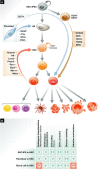'From blood to blood': de-differentiation of hematopoietic progenitors to stem cells
- PMID: 24907133
- PMCID: PMC4198048
- DOI: 10.15252/embj.201488980
'From blood to blood': de-differentiation of hematopoietic progenitors to stem cells
Abstract
Recent studies have reported that fibroblasts or differentiated pluripotent cells can be reprogrammed with transcription factors (TFs) into cells with hematopoietic potential. A study published in Cell now suggests that committed blood precursors may provide a source for blood stem cell transplantation after reprogramming (Riddell et al, 2014). The authors report that a combination of eight TFs reprogram murine committed blood progenitors into long-term engrafting and serially transplantable hematopoietic stem cells with a molecular signature similar to their endogenous counterparts.
Figures

Comment on
-
Reprogramming committed murine blood cells to induced hematopoietic stem cells with defined factors.Cell. 2014 Apr 24;157(3):549-64. doi: 10.1016/j.cell.2014.04.006. Cell. 2014. PMID: 24766805 Free PMC article.
References
-
- Cobaleda C, Jochum W, Busslinger M. Conversion of mature B cells into T cells by dedifferentiation to uncommitted progenitors. Nature. 2007;449:473–477. - PubMed
-
- Kyba M, Perlingeiro RC, Daley GQ. HoxB4 confers definitive lymphoid-myeloid engraftment potential on embryonic stem cell and yolk sac hematopoietic progenitors. Cell. 2002;109:29–37. - PubMed
-
- Mitchell R, Szabo E, Shapovalova Z, Aslostovar L, Makondo K, Bhatia M. Molecular evidence for OCT4 induced plasticity in adult human fibroblasts required for direct cell fate conversion to lineage specific progenitors. Stem Cells. 2014 doi: 10.1002/stem.1721. - DOI - PubMed
-
- Ohnishi K, Semi K, Yamamoto T, Shimizu M, Tanaka A, Mitsunaga K, Okita K, Osafune K, Arioka Y, Maeda T, Soejima H, Moriwaki H, Yamanaka S, Woltjen K, Yamada Y. Premature termination of reprogramming in vivo leads to cancer development through altered epigenetic regulation. Cell. 2014;156:663–677. - PubMed
Publication types
MeSH terms
Substances
LinkOut - more resources
Full Text Sources
Other Literature Sources
Medical

